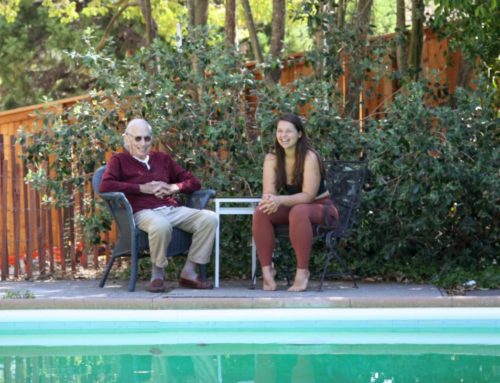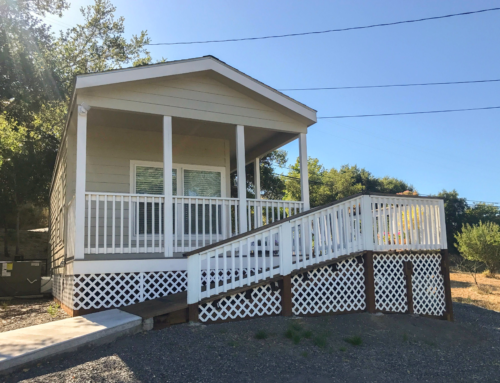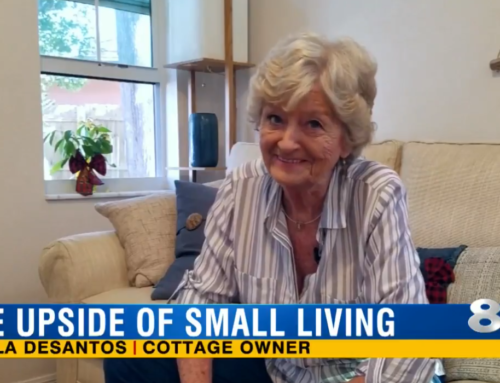Read this article in The Press Democrat
Chris Lind has a spacious house in Petaluma, but sometimes a man just wants to get away to his country cabin.
Lind is lucky; he can be there in a New York minute. A few steps from his back door, he can be stretching out his long legs on the shady front porch of his little “Sugar Shack” as he calls it, looking out at the corn and bee hives and the weathered chicken coops of old Petaluma.
This is Lind’s escape space. Inside, there are creature comforts like a futon, a TV and a DVD player. Lind’s wife, Denise, also likes to mosey down and sit a spell after the pair have tended their chickens and worked their big vegetable garden.
This getaway place is a collaboration between Lind’s dreams and Petaluma-based veteran cabinetmaker Stephen Marshall’s skills. You imagine it and Marshall will build it. Just make sure your dreams are small — 120 square feet, to be exact. Marshall, a Petaluma-based veteran cabinetmaker and builder with 40 years’ experience, has turned his talents to making tiny houses.
He builds heirloom-quality buildings that look like miniature houses, set on a foundation or on wheels. If you ever want to move, you can take it with you.
His most popular are, like Lind’s, only 120 square feet, small enough to qualify under most planning and building codes as sheds, so no building permit is required. Marshall calls it the Sonoma Shanty.
But don’t let the name fool you. Marshall can finish them with recycled Douglas fir floors, old-fashioned beadboard wainscotting, skylights and built-in cabinets. His inspiration is the historic old cabins of Point Reyes.
Legally-speaking, you can’t live in them, although he can make a larger “Little House On the Trailer” that could be professionally transported and set up in an RV park for seasonal living. Marshall uses one of these beautifully finished homes on a trailer — complete with teeny gas fireplace, hardwood floors, crown molding, all-in-one kitchen and compact bath — as an office. His fleet of cute miniature houses has been attracting the attention of passersby on Petaluma Boulevard North.
“I’m driving along and spot them and go. Wow! What’s this?'” recalled Lind, who was looking for a higher-quality building for his garden that didn’t look utilitarian, like your average pre-fab shed.
The Shantys are equipped with electricity but no bathroom or kitchen facilities, in order to stay within the law. Nonetheless, there are still endless possibilities for what Marshall and his wife, Kathryn de Laszlo, see as a little “room of one’s own.”
Lind uses his as a garden getaway. They’ve also been used as artist studios, home offices, workshops, craft and sewing rooms, a playroom for the kids, a teen-agers hangout or a quiet place to read.
Even though you aren’t legally supposed to inhabit them or use them as a bedroom, you could free up space in your house for guests, said Marshall, by moving the home office or work room out to the little house, creating more sleeping space inside.
“You can put in insulation and paneling and wiring. Planning departments don’t speak to what you might do,” he said. “They speak to the structure.”
Marshall has long been fascinated with the economic and aesthetic use of space. He at one time had a sleek Airstream trailer, a classic of design inside and outside.
“It’s like designing a boat. You have to count every inch,” he said, comfortably seated on his couch in the 240-square foot house on a trailer he uses as an office. The ceiling is 10 feet high to add a feeling of spaciousness. Windows are small — 2 feet by 2 feet — and set higher up so as not to consume wall space, which is at a premium.
“Steve has a remarkable skill for economic use of space. He can find more space than you can actually imagine would be there,” said his wife, Kathy.
The small moveable houses on a trailer are essentially RVs but a whole lot more attractive than parking a big motor home on your property, Marshall added.
The 120-square-foot Sonoma Shantys can be had for as little as $12,000 finished or $8,000 unfinished. Lind’s, with his custom Trex deck, arbor and Pergo flooring, was about $25,000.
These tiny units make sense, said Marshall, when you need a little extra space quickly and at less cost. Building permits, he stressed, can cost $15,000 to $50,000 just to add another room or addition to your existing home. You can take them with you if you decided to move, or sell them if you decide you don’t need the square footage any more, or if you want to free up your yard space for some different purpose in the future.
Marshall said the law does allow his larger houses on wheels to be used as caregiver housing. He makes a [Home Care] Cottage that is legally an RV.
The county, he said, allows an RV to be used as a dwelling for an in-home caregiver provided it is connected to an approved sewage disposal system and the home-care need is confirmed by a physician.
The houses on a trailer are legal to move on the highway but too unwieldy to be safely moved like an RV. You really need an experienced mover, he stressed.
His little houses aren’t really houses, although the details add to the illusion. But they do serve a need for inexpensive additional space at a time when home equity lines have dried up and people may find themselves with unemployed family members or grown kids unexpectedly moving in.
“My family in Kentucky went through the Depression and there was bankruptcy there and it ended up there were three generations in the same house,” he said. “That’s sort of what’s happening now.”






